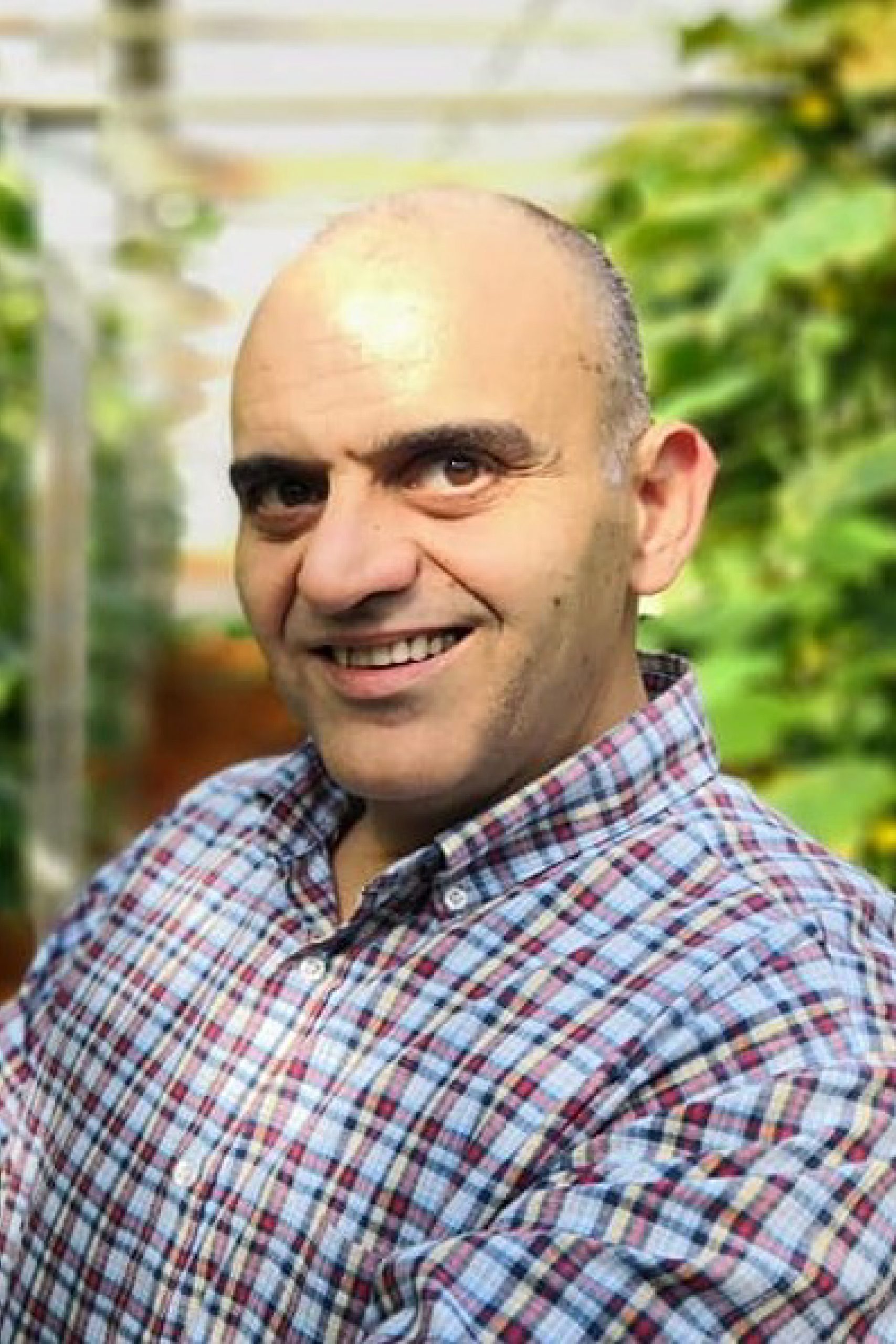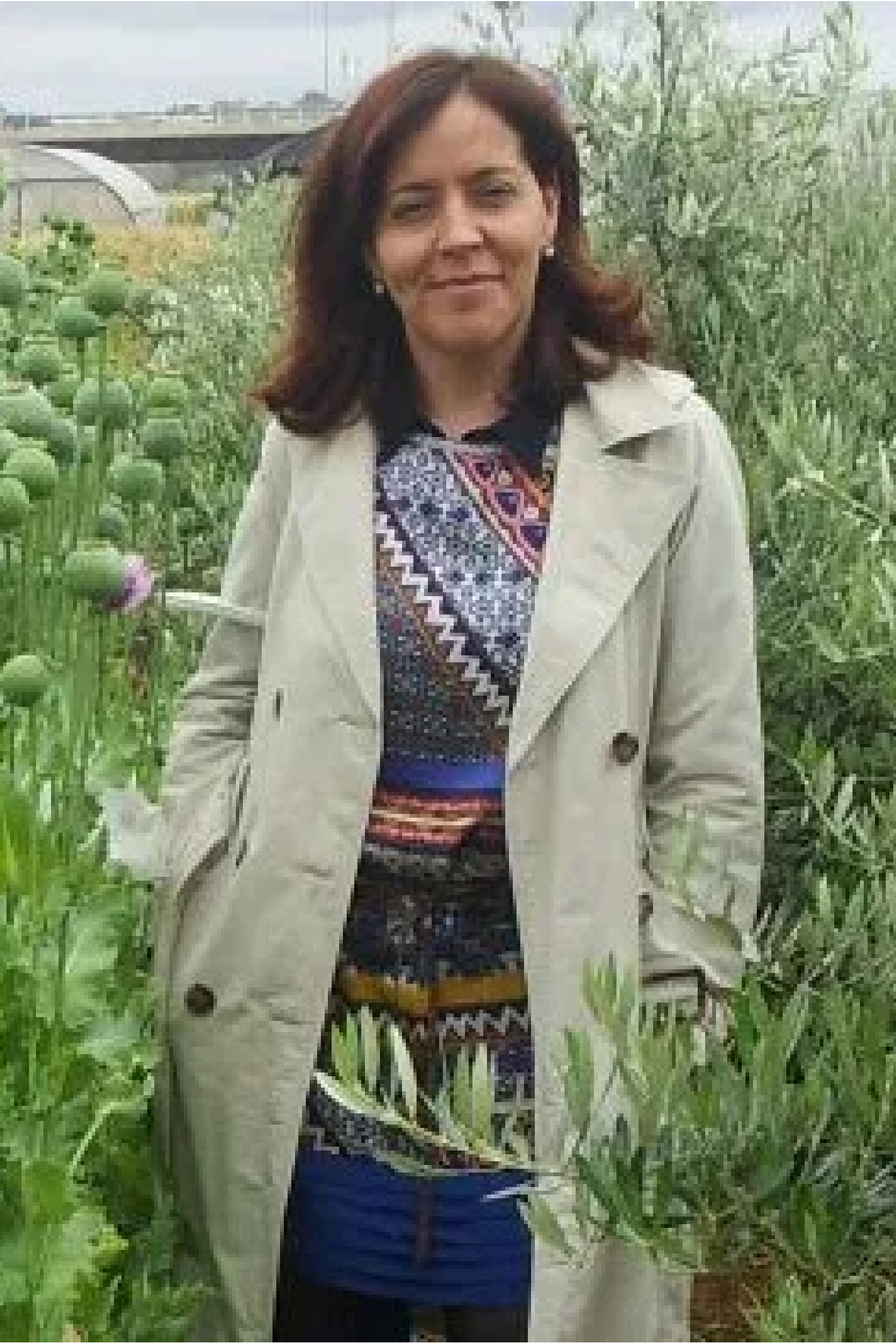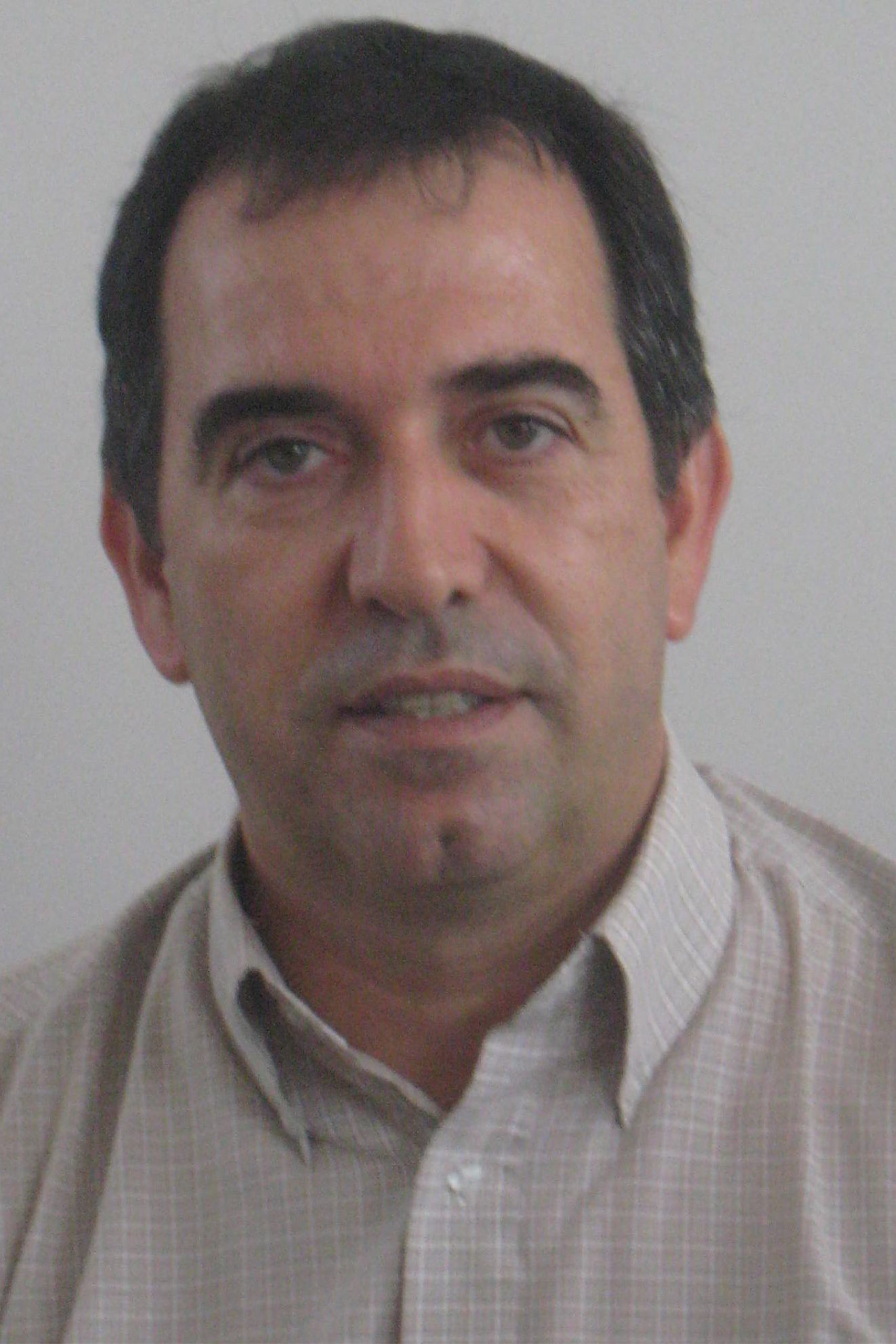Keynote Speakers
- Tito Caffi
- Stéphane Compant
- Diana Fernandez
- Richard E Falloon
- Vasileios Fotopoulos
- Dirk Inzé
- Matteo Garbelotto
- Baldissera Giovani
- Vladimiro Guarnaccia
- George Karaoglanidis
- Blanca Landa
- Antonio F. Logrieco
- Dimitris Tsitsigiannis
- Giuseppe Surico
- Marie-Agnes Jacques
- Anna Maria D’Onghia
- Margreet van der Burg
- Marios Zervas
TITLE:
Innovative Smart Technologies for Agricultural Production and Plant Health
ABSTRACT:
Pests are defined by FAO and IPPC as “any species, strain or biotype of plant, animal or pathogenic agent injurious to plants or plant products”. They can cause enormous crop loss worldwide with damages that can occur in the field, from sowing to harvesting, and also in the storage. Secure food supply for the future generations requires environmentally safe and sustainable production. Main goal of the modern agriculture is to reduce intensive fertilizer and pesticide use and decrease heavy exploitation of natural resources (water, soil, energy). Precision agriculture (PA) is a collection of agricultural practices that focus on specific areas of the field at a particular moment in time. The main goal of precision agriculture can be summarized in doing “the right thing, at the right time in the right place”). With the recent scientific advancements, technological innovations and legislatives tools it is nowadays possible to achieve these strategic goals and to increase sustainability in agriculture. In 2020, the International Year of Plant Health, the use of Smart Technologies can contribute to enhance plant health, reduce hunger and poverty, protect the environment, and boost economic development.
The actual availability of innovative tools and data management techniques, also leading to big data management and analysis requirement, allow to think about an integrated system that provides phytosanitary monitoring for some pilot crops which is effective, rapid, objective, repeatable in the most varied environmental contexts, and therefore suitable to provide appropriate support to the various phytosanitary control needs in a region or an area. It is possible to integrate into modern decision support systems information, protocol, guidance in order to allow trained personnel to carry out surveys and data collection, through information, alerts and guidelines (photographic or video supported) provided by the system.
This approach could lead to a complementary monitoring system and enhancement to the forecast models, an aspect that will allow to optimize and increase the information and alerts provided to the operator, guaranteeing a clearer and more aware picture of the phytosanitary and physiological state of the plant.
BIO:
Dr. Tito. Caffi graduated in Agriculture in 2003 and got the title of PhD in Plant Disease Epidemiology in 2010. Since 2015 he is a researcher in Plant Pathology at DIPROVES – Department of Sustainable Crop Protection – at the Università Cattolica del Sacro Cuore. He is the Instructor of different B. Sc., M. Sc. and Doctorate Courses on Plant Pathology, Crop Protection, Integrated Vineyard Protection and Technologies for Food Safety. He acted as Associate Editor for Plant Disease and he is now Associate Editor for European Journal of Plant Pathology and Phytopathologia Mediterranea. He is the National Coordinator for the EUPLANTCROPP Association (https://euplantcropp.eu).
His research activity is mainly related to the study of the epidemiological and ecological aspects of several pathogens, which affect different field and orchard crops. The main goal of his studies is to develop mechanistic, dynamic, epidemiological models able to simulate pathogens life cycle and to provide information for risk assessment and disease management. Moreover, dr. Caffi is constantly involved in both validation and evaluation of such models under different environmental conditions, and their implementation into Decision Support System aimed to help growers facing the decision-making process related to disease management. Finally, he is also studying and developing innovative methods (i.e. biocontrol agents) and strategies for disease management for organic and IPM farming and the evaluation of systems sustainability.
Click here to read more (Website)

TITLE:
The plant inside as a diverse microhabitat: communities, niches, colonization behaviour of beneficial endophytes and relation to plant growth and health
ABSTRACT:
Plant host different fungal and bacteria in organs like roots, stem, leaves, fruits and seeds. Most of them derive from the soil and the rhizosphere as stated since the XIXth century, but other sources like the anthosphere, carposphere, phyllosphere, laimosphere and caulosphere can also lead to establishment of endophytes inside plant tissues. Other microbes can further derive from animals or from plants growing near each other. A thorough understanding of the communities, routes and niches colonization of endophytes in the phytobiome viewpoint has led to a better knowledge on how to use specific microbes for stimulating plant growth and increase host health but also to understand better how plants shape their microbiome. Most of the research has been done either on fungi or bacteria but recent studies further show that some bacteria can colonize beneficial fungi internally as endofungal bacteria and increase their beneficial effects on plants, leading further to a strategy of using multipartite interaction to boost plant protection.
Session topic: Microbiomes and their role in plant health
BIO:
Dr. Stéphane Compant is Scientist working on plant-microbe interactions at the AIT Austrian Institute of Technology. He received his PhD degree from the University of Reims Champagne-Ardenne and his habilitation from the University of Bordeaux in France. Stéphane Compant was Associate Professor of Microbiology at the National Polytechnic Institute of Toulouse in France before to be project leader at AIT. SC has coordinated several research and training programmes for national and international agencies. He is a leading research expert in microbial ecology of endophytic bacteria and fungi interacting with plants, beneficial or not. He also works on beneficial plant-microbe interactions in general, and biocontrol of plant diseases using various biocontrol agents from different sources. He was member management committee France as well as STSM member on European cost action FA1103. SC also represented Austria on European cost action FA1303, co-chair of microbial ecology, EIP-Agri Pests and Diseases in Viticulture, and serves on various review committees and scientific journal boards.
Click here to read more (Website)

TITLE:
Rice – root-knot nematode molecular interactions: insights for developing new control strategies in crops.
D. FERNANDEZ1,2, A-S. PETITOT1, M. GROSSI-DE-SÁ1, D. AMORA1,2, N.F. MARTINS2, M.F. GROSSI-DE-SÁ2. 1IRD – Institut de Recherche pour le Développement, Montpellier, France. 2EMBRAPA-Recursos Genéticos e Biotecnologia (Cenargen), Brasília-DF, Brazil
ABSTRACT:
Root-knot nematodes (RKNs) are microscopic round worms of the Meloidogyne genus able to parasitize a large number of plants, including important mono- and dicotyledonous plant crops. RKNs settle in roots where they complete their life cycle by feeding from adapted host giant cells. Successful infection is likely achieved by effector molecules produced in the nematode esophageal gland cells and released into host tissues. We used the rice (Oryza sativa) – Meloidogyne spp. pathosystem as a model to gain knowledge into molecular plant-nematode interactions and provide new insights for developing control strategies towards RKNs. Dual RNA-Seq analyses allowed to identify candidate effectors from the M. graminicola secretome. The functional role of Meloidogyne esophageal gland cell proteins was assessed by producing transgenic rice plants expressing the candidate proteins or artificial micro-RNAs (amiRNAs) able to silence the cognate genes in the nematode. A putative role for the MSP18 effector protein in suppressing host immunity was found in tobacco cell death-induced transient assays. In parallel, knowledge on rice innate immunity to RKNs was gained through histological and transcriptomic analyses in the related species Oryza glaberrima. Resistance in rice involved the restriction of juvenile penetration in roots, and later on the degeneration of the giant cells formed. Rice candidate genes proposed as involved in resistance to M. graminicola were identified based on their expression patterns and on a comparative genomic analysis with other RKN-resistant plant species. Some perspectives to control important RKNs based on strategies targeting essential nematode proteins such as RNA interference or structural-based drug design will be presented in conclusions
BIO:
Diana FERNANDEZ got her PhD of Biological Sciences from the University of Montpellier (France).
She is Researcher at IRD (French Institute for Sustainable Development-Institut de Recherche pour le Développement) in Montpellier. She also acted as lecturer for the MSc Plant Pathology at University Montpellier.
She is presently appointed by IRD as full-time visiting Scientist at EMBRAPA- Genetic Resources and Biotechnology, Brasília, Brazil. She also participates in the International laboratory between IRD and INERA in Burkina Faso (LMI PathoBios) for plant diseases monitoring in West Africa.
Diana FERNANDEZ is the President of the French Society of Phytopathology (SFP) since 2014 and Past President (2015-2017) of the European Foundation of Plant Pathology (EFPP)
She acts as Editor of Physiological and Molecular Plant Pathology (PMPP) since 2016 and as Section Editor in Nematology for Tropical Plant Pathology since 2018.
She managed several international projects between France and Brazil, Morocco, Algeria, Burkina Faso and Portugal dealing with plant diseases. She is member of the organizing committee for the next International Congress of Plant Pathology (ICPP2023) in Lyon, France.
Her research interests are focused on plant diseases of tropical crops important for developing countries, including coffee leaf rust, date palm fusariosis, sudden mango decline and root-knot nematodes interactions with rice and coffee. Diana FERNANDEZ develops researches in molecular plant-parasite interactions with focus on fungi and nematodes effectors, mechanisms of plant resistance, population genetic structure of pathogen species and molecular diagnosis of plant pathogens.
Click here to read more (Website)

TITLE:
Phytopathologia Mediterranea: a journal with distinguished history, burgeoning impact, and a key place for international plant pathology knowledge transfer
Richard E. Falloon1, Laura Mugnai2 & Alessandro Pierno3
1New Zealand Institute for Plant & Food Research Limited, Christchurch, New Zealand
2Università degli Studi di Firenze, Firenze, Italy.
3Firenze University Press, Firenze, Italy.
ABSTRACT:
TBA
BIO:
Richard Falloon graduated in Microbiology from the University of Canterbury, New Zealand, and in Plant Pathology from the University College of Wales Aberystwyth, United Kingdom. He has worked as a research plant pathologist for 48 years, studying diseases affecting pasture, arable and horticultural crops. His research has included characterisation of fungus and protozoan plant pathogens, determining their effects on quality and quantity of crop production, and evaluating methods for disease management. For the last 25 years he has focused on soilborne diseases of potato, particularly those caused by the plasmodiophorid pathogen Spongospora subterranea.
Prof Falloon has held key leadership positions in plant protection learned societies, including President of the New Zealand Plant Protection Society (NZPPS), President of the Australasian Plant Pathology Society (APPS) and President of the International Society for Plant Pathology (ISPP). He is a Life Member of the NZPPS, and Fellow of the APPS, the ISPP and the New Zealand Institute of Agricultural & Horticultural Science (NZIAHS), and was presented the NZIAHS Jubilee Medal, that Society’s most prestigious award. Prof Falloon has worked at the Bioprotection Research Centre, Lincoln University, as Deputy Director, and is currently Senior Research Fellow in the New Zealand Institute for Plant & Food Research, and Honorary Professor (Plant Pathology) at Lincoln University, Canterbury, New Zealand. He is CoEditor-in-Chief of Phytopathologia Mediterranea, the international journal of the Mediterranean Phytopathological Union.
Click here to read more (Website i / Website ii)

TITLE:
Plant and seed priming for improved growth and abiotic stress protection under a changing climate
ABSTRACT:
Increased frequency of extreme environmental events resulting from global climatic changes remarkably influences plant growth and development. Close examination of plant-to-plant communication in nature has revealed the development of unique strategies from plants for responding to abiotic stress, with one of the most interesting being through priming for improved defense responses. The process of priming involves prior exposure to a biotic or abiotic stress factor making a plant more tolerant to future exposure. Priming can also be achieved by applying natural or synthetic compounds which act as signaling transducers, ‘activating’ the plant’s defense system. An up-to-date overview will be presented describing the research carried out at the Cyprus University of Technology using priming agents towards induced acclimation of plants to environmental challenges. In addition, recent findings will be presented on the evaluation of chemical compounds as well as nanoparticles that potentially display growth promoting properties in plants, closely related to our existing expertise and previous observations in priming against stress.
BIO:
Vasileios Fotopoulos is Associate Professor in Structural and Functional Plant Biology and head of the CUT Plant Stress Physiology Group established in 2008 (www.plant-stress.weebly.com). He obtained his BSc in Horticulture from Wye College, University of London, and his MSc in Pest Management (Plant Disease) from Imperial College London. He holds a PhD in Plant Molecular Biology from the University of Southampton, U.K. His post-doctoral research was carried out at the Department of Pharmaceutical Sciences, Aristotle University of Thessaloniki, as well as in the Institute of AgroBiotechnology, CE.R.T.H. His main scientific research focuses on the study of nitro-oxidative signaling cascades involved in the plant’s response to stress factors, while emphasis is currently being given in the development of chemical and biological treatment technologies towards the amelioration of abiotic stress factors and promotion of plant growth. To date, Dr. Fotopoulos is the author of 63 scientific papers published in peer-reviewed journals (h-index=26), while he serves as Associate Editor in BMC Plant Biology, Gene, Frontiers in Plant Science and five other journals.
Click here to read more (Website)

TITLE:
1. Plant Biology and Climate Emergency
2. Genome editing: Enabling genome editing for European agriculture: will scientific evidence prevail?
ABSTRACT:
1. The world is experiencing an unprecedented climate crisis that requires urgent action at all fronts. Plant biology offers great opportunities both for adapting to climate change as well as for mitigating the accumulation of greenhouse gasses.
It is expected that higher temperatures and longer drought episodes will greatly reduce crop productivity in many area’s including the Mediterranean basin. Understanding how plants rewire their growth and development in response of environmental cues such as drought is the first step towards breeding and/or engineering stress tolerant crops. I will illustrate the challenges of achieving this ambitious goal by our research on drought responses in maize. The molecular and phenotypic comparison of drought response of maize plants cultivated in growth chambers, greenhouse and field conditions highlighted the importance of applying an experimental ‘lab to field to lab’ approach. Furthermore, drought responses involve many interacting genes. Genome editing offers great perspectives not only to tackle complex multi-genic traits such as drought but also to engineer drought tolerant crops.
Plants are fantastic organisms that evolved to efficiently use CO2 for growth and development. The selection of plants with improved CO2 sequestration capabilities, above ground and below ground, are likely to become a valuable tool to combat climate change. Obviously such plants should be resilient to environmental stresses and show a low dependency on fertilizers and agrochemicals. I will discuss various approaches on how to develop such plants for climate emergency.
2. Agriculture and food production must become more sustainable in a world facing a growing population under changing climate conditions and environmental degradation. All possible approaches, including improved plant breeding technologies, are essential to address these challenges. In order to develop new crop varieties, scientists and plant breeders need to have access to the widest possible array of breeding tools. The most recent addition to the toolbox is precision breeding, also known as genome editing with a preference for CRISPR. This technology allows for scientists and breeders to develop desired crop varieties in a faster, relatively simple and much more directed way compared to older breeding technologies.
However, there are legal and procedural uncertainties regarding the status of genome edited crops in Europe. While the CRISPR technology is being adopted at an unprecedented speed, the current regulatory framework remains outdated. Moreover, the European Court of Justice (ECJ) ruling from 2018 (C-528/16) brought even more confusion because of the interpretation that crops obtained by precision breeding are subject to the GMO regulatory provisions. This regulatory burden even applies to crops with the smallest, specific CRISPR-mediated DNA alteration, that can also occur spontaneously in nature.
The ruling leads to inconsistency in the legislation because of the fact that conventional mutagenesis -which results in thousands of random DNA alterations- is exempt from the GMO regulatory provisions. The legislation no longer correctly reflects the current state of scientific knowledge. Besides, subjecting genome-edited crops to the current EU GMO regulation will delay the development of climate-resilient crops, hinder progress in sustainable agriculture, reduce EU’s competitiveness and hamper global trade.
The ruling is hampers the cultivation of genome edited crops with beneficial traits for our health or the environment such as improved nutritional composition, improved digestibility, lower content of anti-nutritional components, reduced allergenicity or requiring less input.
The scientific community in Europe responded united and published a position paper and an open statement to call upon the European Commission and the European Parliament. With a growing number of signatories, reaching currently to 129 European research institutes and organizations, from 21 different Member States and the UK, the network EU-SAGE was launched. EU-SAGE stands for European Sustainable Agriculture through Genome Editing and aims to provide information about genome editing and to promote the development of European and EU member state policies that enable the use of genome editing for sustainable agriculture and food production. I will provide an update on the ongoing discussions with the European Commission. Hopefully scientific evidence will prevail.
BIO:
Dirk Inzé is a global leader in plant biology and an ISI ‘most cited author’. His research ambition is to obtain a holistic understanding of the molecular networks regulating plant organ growth and crop productivity. His work has opened up new perspectives for the identification of optimal growth regulatory networks that can be selected by advanced breeding, or for which more robust variants can be obtained through genetic engineering. As such, Dirk Inzé’s work significantly contributes to providing food security for the growing world population.
Dirk Inzé received his PhD at Ghent in 1984. In 1990, he was appointed Research Director of the French National Institute for Agricultural Research (INRA), where he initiated highly successful research programs on the plant cell cycle and growth control. In 1995, he became Professor at Ghent University and he was the scientific founder of the biotechnology company CropDesign, which was established in 1998 and acquired in 2006 by BASF Plant Science. In 2002, Dirk was appointed Director of the Center for Plant Systems Biology of the VIB. Under his directorship, the Center for Plant Systems Biology – currently employing approximately 300 individuals – became one of the world leading centers for advanced plant sciences. Dirk’s research was recognized by numerous awards and he is a member of several science advisory boards. Dirk currently owns, for the second time, an advanced ERC grant and his work received >51,000 citations (H-factor 129). In 2017, Dirk was awarded with the prestigious World Agriculture Prize. In 2019 he was elected to the rank of AAAS Fellow by the American Association for the Advancement of Science (AAAS).
Click here to read more (Website)

TITLE:
Cypress Canker: a model pathosystem to study fungal invasions
ABSTRACT:
TBA
BIO:
Click here to read (Website)

TITLE:
Euphresco as a platform to link research and policy in the Mediterranean area and abroad
ABSTRACT:
TBA
BIO:
Dr Giovani holds a PhD in biochemistry and molecular biophysics and worked for a number of years as a researcher in world leading universities, governmental agencies and private companies. Since 2008 he has been interested in research funding, international research cooperation and transnational public‐public partnership. He joined EPPO in 2014 as coordinator of the Euphresco network for phytosanitary research coordination and funding.
Click here to read more (Website)

TITLE:
Fungal pathogens of wood: are they a threat to Mediterranean fruit crops?
ABSTRACT:
Intensification, diversification and globalization regularly happen, causing a broad range of collateral effects on agriculture. The risks of disease dissemination via trade and the movement of goods and people is increasing. Moreover, climate change is also affecting plant health by modifying the interactions between host plants, pathogens and the environment.
Fruit tree plantations are increasingly threatened by fungal diseases. It has been also observed how fruit trees share fungal pathogens with woody plants that are not considered to be trees. Both primary and opportunistic pathogens can cause various symptoms such as cankers, twig blight and wood rotting. Diaporthe and Neofusicoccum spp. are examples of pathogens able to infect a broad range of fruit trees. Moreover, there are numerous latent pathogens such as those in the Diatrypaceae family or in the Cytospora and Neocosmospora genera, and many others.
Recent findings about fungus/host combinations will be presented, with emphasize on the connection between species identification studies and the development of modern diagnostic tools. Moreover, factors such as cultivar diversity, propagation material health and rootstock selection, need to be investigated in relation with the pathogens, for providing the necessary support to the producers of a such high economic important agriculture sector.
BIO:
Vladimiro Guarnaccia obtained his PhD in Plant Health Technologies and Protection of Agro-ecosystems at University of Catania, Sicily, where he has worked up to 2015 on fungal pathogens of ornamental plant and tropical fruit crops in the lab group of Full Professor Giancarlo Polizzi. Then, he moved to The Netherlands working as post-doc researcher at Westerdijk Institute (formerly CBS). Here, guided by Full Professor Pedro Crous, explored the fungal species causing wood diseases of citrus and other fruit crops. He worked at the University of Stellenbosch, South Africa, involved in different projects guided by Dr Jan Van Niekerk about characterization and biological control of fungi causing trunk disease of citrus trees.
Since February 2019, he is Assistant Professor at the University of Torino, working in the team of Agroinnova, where a broad research programme is led by Full Professor Lodovica Gullino. Berry fruit, apple, cherry, peach and other fruit crops are economically important in Northern Italy. Thus, he is currently working on wood diseases of these crops, looking at the fungi involved, their association with stressed plants and pre-plantation diagnostic.
Member of the editorial board of “Phytopathologia Mediterranea” and “FUSE” journals, he is active peer-reviewer for many scientific journals on Plant Pathology and Mycology.
Click here to read more (Website)

TITLE:
Fungicide resistance in Botrytis cinerea populations from protected crops in the Mediterranean basin: Current status and implications with its management
G. KARAOGANIDIS. and A. SAMARAS. Plant Pathology Laboratory, Faculty of Agriculture, Forestry and Natural Environment, Aristotelian University of Thessaloniki, POB 269, 54124, Thessaloniki, Greece E-mail: gkarao@agro.auth.gr
ABSTRACT:
Botrytis cinerea is one of the most destructive pathogens infecting numerous crops. Among them are included several important crops cultivated in the Mediterranean basin such greenhouse grown vegetables or strawberries. Resistance of the pathogen to fungicides used for its control is widespread throughout the Mediterranean basin in crops heavily treated such as those cultivated in greenhouses and it is associated with reduction in product`s performance and control failures.
In this report the current status of resistance to major botryticide groups such as SDHIs, QoIs, hydroxyanilides or anilinopyrimidines in Botrytis spp. populations will be reviewed and detailed information will be given on the methodologies of resistance detection, variability of mutations conferring resistance to fungicides, their effect on the fungal sensitivity to the different active ingredients and the fitness of resistant strains. Furthermore, implications of cross-resistance patterns complexity and fitness cost for the resistant mutants will be discussed in relation to resistance management in greenhouse grown vegetables taking into account the recent introduction of new active ingredients into the agricultural practice, such as new molecules belonging into SDHIs.
Additionally, future prospects and challenges will be presented with emphasis on the role of alternative control methods such as the integration of Biological Control Agents (BCAs) with conventional fungicides in reducing the fungicide selection pressure on fungal population and, thus, minimizing the risk for resistance development.
BIO:
Associate Professor George Karaoglanidis is plant pathologist with more than 20 years of research experience in the field of Plant Pathology. His research interests focus on: a) investigations related to fungicide resistance development by plant pathogenic fungi (resistance mechanisms, development of resistance detection methodologies, development of fungicide resistance management measures), b) development and evaluation of disease control strategies alternative to the chemical control, and c) investigations on the etiology and characterization of postaharvest pathogens. He is author of: a) 58 papers published in SCI journals (citations >1.100, h-index 22), b) 4 review book chapters and c) 126 oral/poster presentations in international and national conferences (several of them as invited speaker). He has served as reviewer for >180 paper submitted to SCI journals, while he has participated in research proposals evaluation panels submitted in national and EU calls. He has served as coordinator in 5 research projects funded by GSRT while he has participated as member of the research consortium in more than 10 research projects funded by EU or national funds.
Click here to read more (Website)

TITLE:
Current situation of Xylella fastidiosa in Spain: Main research projects ongoing to understand and tackle this pathogen
ABSTRACT:
TBA
BIO:
Research scientist in Plant Pathology at the Institute for Sustainable Agriculture, Spanish National Research Council (CSIC). I have devoted most of my career to the study of : i) the biological quality and phytosanitary status of soils and the environmental and agronomic practices influencing it; ii) soil suppressiveness to soilborne plant pathogens; iii) isolation and selection of microbial antagonists to control plant pathogens; and iv) study of the plant microbiome and its role in modulating host response to xylem-inhabiting wilting pathogens. In the last years, I have focused my research on the study of the biology and epidemiology of the main Vascular diseases of olive (Verticillium dahliae, Xylella fastidiosa) and the development of diagnostic tools and management methods to fight them.
Click here to read more (Website)

TITLE:
MycoKey: mycotoxin risk and innovative key actions for management along chain
ABSTRACT:
TBA
BIO:
Dr. Antonio F. Logrieco, Director of CNR-ISPA (http://www.ispacnr.it/). Scientific responsible and coordinator of various national and international projects dealing on Plant pathology and food safety, with particular attention on mycotoxin problem including MycoKey; “Integrated and innovative key action for mycotoxin management in the food and feed chain) –MycoKey Horizon 2020 (http://www.mycokey.eu/ ) .
He is former Past-President of International Society for Mycotoxicology (http://www.mycotox-society.org) and acting President of Mediterranean Phytopathological Union (http://www.mpunion.eu/) . He was President of ISPP “Fusarium Committee”.
Elected as member of Hungarian Academy of Sciences and nominated as Distinguished International Supervisor of Institute of Food Science and Technology, Chinese Academy of Agricultural Sciences. Honorary instructor of annually Fusarium training workshop at Kansas State University, USA.
Click here to read more (Website)

TITLE:
Integrated pest management smart technologies to precisely detect and control plant diseases
ABSTRACT:
TBA
BIO:
Assοciate Professor of Plant Pathology
Director of Plant Protection and Environment Section
Agricultural University Of Athens
Ass. Prof. Dimitris Tsitsigiannis research group is working on developing and evaluating in the lab and in the field more effective, smart, durable and environmentally sustainable integrated management strategies to control important plant diseases utilizing classical, molecular and innovative plant pathology approaches. His special research interests are: 1) Smart solutions to improve diagnosis, forecasting, monitoring and management of plant pathogens and diseases utilizing technology and service innovations (e.g. applications for remote and mobile diagnosis, precision agriculture) 2) Integrated management of mycotoxigenic fungi and mycotoxins in pistachios, grapes, corn and barley (epidemiology, evaluation of resistant/tolerant varieties, evaluation of biocontrol products and fungicides), 3) Integrated management strategies of olive anthracnose and Alternaria bud and blossom blight of olives, 4) Elucidation of pathogenicity mechanisms of mycotoxigenic fungi and the soilborne plant pathogen Verticillium dahliae. 5) Investigation of the role of novel genetic factors and molecular mechanisms involved in plant innate immune system.
Web personal/lab page: http://efp.aua.gr/en/userpages_en/52
Click here to read more (Website)

TITLE:
The construction of an empire: Xylella fastidiosa at the conquest of the Mediterranean Basin
Giuseppe Surico and Guido Marchi
ABSTRACT:
Although Xylella fastidiosa officially started the invasion of the Mediterranean Basin in 2013, it is believed that its escape from the American borders happened multiple times in the past century. While this conviction is not based on direct evidence, it arises from specific studies on the subject. However, even if X. fastidiosa has arrived in the Mediterranean Basin many years ago, there isn’t currently enough information to advance a credible hypothesis that could explain the long and silent period of time the bacterium may have spent in one or more host plants.
After its first appearance in California around 1885, the bacterium has apparently invaded, in just over a century, the North, South and Central America causing new diseases. On olive, it was detected for the first time in California only about 15 years ago. This has become possible mainly through the combination of two types of events: its spread to new areas and the external manifestation of disease. This means that for a long period of time, ancestral forms of X. fastidiosa have established a simple parasitic or symbiotic relationship with some host plants, becoming pathogenic only recently and only on some plant species. These new populations have arisen mostly, if not exclusively, through intersubspecific homologous recombination. At the moment, six subspecies of X. fastidiosa are known: fastidiosa, multiplex, pauca, sandyi, tashke and morus. Each of these subspecies has its own range of hosts and geographical distribution. For example, subspecies multiplex (the epithet meaning “numerous”, “many”) can attack many different plant species including oak, elm, maple, almond, sycamore, Prunus sp., etc; while subspecies pauca (“little”, “few in numbers”) was until now known to cause serious problems to coffee and citrus species only. After the invasion of the Mediterranean Basin by X. fastidiosa some of the old knowledge needs to be revised. The most sensational example is given by the strain that has infected olive in the Salento Peninsula of Italy: a strain genetically classified as subspecies pauca but whose phytopathological behaviour is typical of strains in subspecies multiplex. Likely, we are just starting to witness new and complicated phenomena and it is unknown how all this will evolve.
At the moment, X. fastidiosa has been reported in at least 7-8 different areas of the Mediterranean Basin. Each of these areas has experienced new bacterial introductions rather than the spread of strain ST53 which invaded the Salento Peninsula. This means, inter alia, that the European alert system designed to block the entrance of alien pathogens, failed or did not work enough. Therefore, a reflection to this regard by policy makers and phytopathologists alike is warranted.
BIO:
Click here to read (Website)

TITLE:
Research mobilization in France to fight the threat posed by Xylella fastidiosa
Marie-Agnès Jacques, Martial Briand, Enora Dupas, Sophie Cesbron.
ABSTRACT:
Once thought to be restricted to the Americas, the plant-associated bacterium Xylella fastidiosa has been blooming since 2013 in Europe. Strains of this bacterium were detected in 2015 in Corsica and later on in continental France. A large diversity of plants comprising mostly ornamental plants was detected infected by diverse strains of the bacterium. Comparative genomics and adapted typing methods allowed to reconstruct their evolutionary history and to give clues concerning its routes of introduction. French research teams contribute to a better knowledge of this priority pathogen by providing complementary knowledge of the biology of this pest, its dissemination and factors impacting dispersal, and the trophic network involving this bacterium, its hosts and its vector. This research mobilization is included in the large European research mobilization and has beneficiated from dedicated European projects.
BIO:
MAJ got her PhD from Paris-Orsay University in 1994 on a thesis dealing with Quantitative ecology and physiology of the epiphytic bacterial community. She participates in the first studies showing that epiphytic bacteria are forming biofilms on leaf surfaces with Cindy E. Morris, INRA France. She went to Oxford, UK for a one-year Post-Doc in Mark Bailey’s lab to learn molecular methods to characterize bacterial strains in biofilms. She got hired at INRA and developed her own project on epidemiology and ecology of seed-borne bacterial diseases with a focus on bean-associated aerial diseases and role of biofilms in epidemiology and seed-transmission. More recently, she got involved in several projects focusing on leaf-associated commensal bacteria, their interactions with pathogenic bacteria, their potential role in evolution and emergence of novel pathogens.
She has been involved in projects dealing with Xylella as soon as the first contaminated plants were detected in France in 2012. In order to properly identify the strains isolated from intercepted plant material and later on from naturally infected plants from natural settings in Corsica and in PACA region, France, she used various taxonomic assignation and typing methodologies, and propose novel assays. Her main projects aim at identifying the host range of strains detected in France and gain a better understanding of the evolutionary history of this pathogen and decipher its route of invasion.
Click here to read (Website)

TITLE:
1.Ciheam Policy in Plant Health to Enhance Food Security in the Mediterranean Region
2. Applications of remote sensing and information technology in the surveillance of quarantine diseases of fruit tree crops
ABSTRACT:
1.Most of pests and diseases affecting Mediterranean crops are seriously compromising food security and, consequently, the sustainability of rural populations in several countries in the Mediterranean region. The importance of Plant Health has been clearly highlighted by UN that has declared the 2020 as the International Year of Plant Health. CIHEAM, an intergovernmental Organization of 13 Member States, has gained a long experience in plant health which is one of the main pillars of the CIHEAM Strategic Agenda 2025 – adopted in 2016 by the Ministries of Agriculture of CIHEAM Member States. It is approached through: training of researchers, officers, professionals; applied research linking local scientists with the international research communities; participatory governance that means encouraging discussions and interactions among scientific, institutional and private stakeholders; and cooperational developing programmes enhancing country capacity building and awareness raising. The CIHEAM Institute of Bari, in particular, has more than 30 years of experience in plant health, implementing and financing numerous international research initiatives in the Mediterranean region and neighboring countries (e.g. Iran, Sultanate of Oman, Iraq). It is also engaged in several initiatives funded by the Italian Cooperation addressing plant health in several countries (Mediterranean, Balkan, African, Near eastern and Middle eastern countries). These initiatives have delivered institutional capacity building and technical assistance to hundreds of officials of national and local entities. Furthermore, in line with the statutory mission of CIHEAM Bari (higher education, research and development cooperation), since 1985 the Institute has delivered specialized and post-graduate diplomas on Integrated Pest Management to thousands of trainees coming from over 50 countries. Particular attention of CIHEAM is posed on early surveillance, detection and control of transboundary pests and diseases which may seriously threat crops, environment and sustainability of rural populations (e.g. Xylella fastidiosa). The achieved results have demonstrated that it is possible to ensure the shift towards sustainable production if quarantine measures are strengthened and a comprehensive phytosanitary management is applied. CIHEAM initiatives are therefore focusing on harmonizing national rules with the EU technical/ phytosanitary/ legal standards, in order to safeguard agriculture and promote improvement in domestic and export trading of safer food in conformity with Governments’ strategic plans.
2. Early and accurate detection systems for quarantine diseases of fruit tree species are essential for efficient large-scale surveillance, rapid implementation of control measures and evaluation of their effects. The new frontiers of technology can also offer several smart solutions in the field of plant health, facilitating the task of operators in implementing more efficient, accurate, timely and cost-effective real-time and large-scale surveillance programs. It is therefore necessary to have a considerable amount of data (e.g. climate, geographical, satellite, diagnostic) accurately captured at a distance and on the ground, using applications, sensors, forecasting models, specific diagnostic methods, etc. To this aim, Remote sensing (RS) can help to identify infections on a large scale, even when symptoms are not yet visible. There are many platforms and sensors designed for the acquisition of remote sensing data, ranging from satellite, aircraft and, more recently, UAS. The availability of high resolution time series of images such as Sentinel-1 and Sentinel-2, introduced with the European Copernicus programme, has greatly facilitated the scale-step in the use of Earth Observation (EO) data for agricultural and phytosanitary applications. In addition to RS, Information Technology (IT) is another important tool for plant protection programs allowing accurate storage, retrieval, transmission and manipulation of monitoring data. Various IT tools can be used for this purpose such as diagnostic devices, Apps (accurate on-site data acquisition), DSS, etc. An overview on RS and IT systems is provided, with particular reference to those already available and applied in the official pathogen monitoring programmes (Citrus tristeza virus, Xylella fastidiosa in Apulia region, Italy), e.g.: (i)an automatic procedure for tree counting, using GeoEye-1 multispectral image; (ii)prediction maps using WordView-2 satellite image in GIS environment for early detection of CTV-suspected trees; (iii)photointerpretation of high-resolution aerial images for the identification of OQDS trees in the demarcated area of X. fastidiosa; (iv)several applications for accurate field data acquisition by NPPOs (e.g. Apps for Xylella fastidiosa, XylApp, XylAppEU, XylAppNENA) and citizens (XylAppcitizens); (v) integrated DSS made of database, forecasting models and users interfaces.
BIO:
Head of the Knowledge Unit on Precision Crop Protection
Scientific Coordinator of the CIHEAM International Master of Science on ‘Precision IPM of fruit and vegetable crops’
Coordinator of the CIHEAM Bari National Accredited Laboratory of for official diagnostic analyses of harmful plant pathogens
Head of the CIHEAM Bari Center for the production and conservation of pathogen-free accessions of fruit tree species
She has over 30 years of experience in education/training, applied research and international cooperation in:
- Integrated Pest management
- Certification of plant propagating materials and Plant quarantine
- Pest surveillance, monitoring, detection, characterization, epidemiology and control
Over the last 12 years she has focused research on Precison Crop Protection: remote sensing and computer applications in combination with forecasting models and advanced diagnostic methods for early pest surveillance, detection and control.
CIHEAM representative at the board of several international organizations, e.g
- Mediterranean Phytopatological Union (MPU)
- EUPHRESCO (EU PHytosanitary RESearch COordination and funding)
Member of the IPPC/FAO Scientific Committee of the International Year of Plant Health 2020 (IYPH2020)
EUPHRESCO award as ‘Scientist of the month’ for the coordination of the project PHeRS on ‘Remote sensing applications in plant health’
Coordinator/WP leader of several research projects, e.g.
- MULTITRACE (Italian Ministry of Economic Development) – Advanced computer systems and technologies for traceability in Phytopathology
- AGREED (Italian Ministry of Economic Development) – Agriculture, Digital and Green
- Xf-ACTORS (EU-Horizon 2020)- Implementation of sampling schemes and innovative tools for early detection of X. fastidiosa in host plants and insects
Co-Editor of 6 books, co-author of 1 chapter and co-author of over 250 publications in scientific journals.
Co-Editor for Phytopatologia Mediterranea and reviewer for various scientific journals (e.g. Plant Pathology, Journal of Phytopathology)
Click to read more information (Website)

TITLE:
Gender in plant health and pathology: exploring the research agenda
ABSTRACT:
This presentation will take the audience on a short journey to explore gender into the plant pathology research agenda. With some historical and contemporary examples it will be illustrated how women differently from men are connected to plant health and pathology and its research. It ends with showing windows of opportunity what research including gender can help dealing with the current challenges the field faces.
BIO:
Margreet van der Burg is senior university lecturer/research Gender Studies at Wageningen University, the Netherlands. She examines food, agricultural and rural research and development from a gender perspective. She takes in the gender dimension as also intersecting with other social dimensions. Her work includes gender and the development of agricultural educational and knowledge systems, family farming, agriculture oriented organisations, as well as rural, agricultural and food iconography and heritage. She expanded her work from the Netherlands to the European/western level, and from 2000s onwards to the global level, both historical and contemporary. Within her position at Wageningen, in 2006 she also served as Rural Gender Studies Guest Professor in the Maria Goeppert-Mayer Professoriate Program from German Lower Saxony, at the Institute for Rural Development, Faculty of Agricultural Sciences, Goettingen, Germany. 10 years later she was visiting scholar with Carolyn Sachs, Professor in Rural Sociology and Women’s Studies at PennState University USA. Currently, she is daily project leader of the EU Horizon 2020 Gender-SMART project for her institution, and within the project consortium she is workpackage leader for the integration of gender into education, research and funding. Through the years, she engaged in many professional and outreach activities such as TV documentaries, travelling exhibitions, and conferences as well as in building professional networks and organisations.

TITLE:
Open Access as a publication model challenges and perspectives
ABSTRACT:
Today, an increasing number of researchers and scientists follow Open Access. Open Access is a movement that offers the research and academic community the opportunity to disseminate, share and access research output freely by removing price and permission barriers. Although there are a number of challenges that have to be addressed, at both the infrastructure and the policy level, the most important is the implementation of national and EU open policies and funders mandates. The European Union and a group of national research funding organizations, in order to promote OA, established coalition S”. Effective in 2021, all scholarly publications resulting from funded research by public or private grants provided by national, regional, and international research councils and funding bodies, must be published in Open Access Journals, on Open Access Platforms, or made immediately available through Open Access Repositories without embargo.
cOAlition S endorses a number of strategies to encourage subscription publishers to transition to Open Access. The Library and Information Services at the Cyprus University of Technology (CUT) has defined Open Access as one of its main strategies and offers two author funds to the local research community. Ktisis CUT Institutional repository is compliant with COAR next generation repositories. COAR and cOAlitions S cooperate in order to support IR in the implementation of the directives of Plan S. COAlition S also supports transformative contract and transformative publishers. In this presentation, we are going to discuss all these challenges and perspectives in support of promoting OA.
BIO:
Marios Zervas studied at the CNAM (Centre National des Arts et Métiers, Paris, France), where he obtained the DEST (Diplôme d’Etudes Supérieures et Techniques) Génie Informatique. He also holds an MBA from the Open University of Cyprus.
He started his career in 1989 as a Project Manager at “Télédiffusion de France –Radiomessagerie, Paris France”. After relocating to Cyprus in 1994, he became the I.T. Officer at the Library of the University of Cyprus. Since 2006 he is the Library Director of the Cyprus University of Technology.
His responsibilities include performing research in areas related with digitization and developing various digital collections in order to preserve the Cyprus cultural heritage, library services and information literacy.
He is a member of the advisory committee of the Cyprus National Library and vice president of the Cyprus Libraries Consortium.
He is a member of the IFLA advisory committee of School Libraries.
He was a member of the advisory committee of the Cyprus Theater Museum.
He was the local organization chair for the international conferences Elpub2017 and MTSR2018. He will be the Local Organization Chair for the oncoming conferences CRIS2020.
His interest is in various research areas, especially in OPEN ACCESS, where he has undertaken many initiatives in order to promote OPEN ACCESS and he has written many research papers.
Click here to read (Website)

